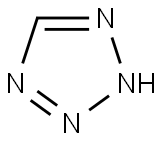Pentetrazol
Synonym(s):α,β-Cyclopentamethylenetetrazole;1,5-Pentamethylenetetrazole;6,7,8,9-Tetrahydro-5H-tetrazolo[1,5-a]azepine;Metrazole
- CAS NO.:54-95-5
- Empirical Formula: C6H10N4
- Molecular Weight: 138.17
- MDL number: MFCD00005939
- EINECS: 200-219-3
- SAFETY DATA SHEET (SDS)
- Update Date: 2024-12-18 14:08:52

What is Pentetrazol?
Description
Pentylenetetrazole (PTZ) is a central nervous system modulator that is used to experimentally induce seizures in animals. Subcutaneous PTZ has been used extensively to screen for compounds that block the production of nonconvulsive (absence or myoclonic) seizures. PTZ has diverse, site-specific effects in the brain. However, it is an antagonist of GABAA receptors and some drugs that block PTZ-induced seizures, including benzodiazepines, act at the GABAA receptor.
Chemical properties
white crystalline powder
Originator
Pentylenetetrazole,Spectrum Chemicals and
The Uses of Pentetrazol
Non-specific CNS stimulant; convulsant; narcotic antagonist.
The Uses of Pentetrazol
analeptic, circulation stimulant
The Uses of Pentetrazol
Pentylenetetrazole has been used to induce seizures in zebra fish larvae, mice, and male wistar rats.
What are the applications of Application
Pentylenetetrazole is a useful biochemical in neurotransmitter studies
Definition
ChEBI: An organic heterobicyclic compound that is 1H-tetrazole in which the hydrogens at positions 1 and 5 are replaced by a pentane-1,5-diyl group. A central and respiratory stimulant, it was formerly used for the treatment of cough and other espiratory tract disorders, cardiovascular disorders including hypotension, and pruritis.
Manufacturing Process
A solution of 9.8 g cyclohexanone and 8.6 g HNO3 in about 250 ml benzene were slowly added dropwise to 20 ml concentrate sulfuric acid in 100 ml benzene by ice cooling and stirring. After ending of a generation of N2 (0.1 moles) to a corresponding quantity of cyclohexane (0.1 moles). Acid layer was diluted with ice, and made neutral with strong alkaline to give a reaction product as oil. Then it was exrtacted with chloroform, all solvents were distilled and the residue was diluted with water. The desired 6,7,8,9tetrahydro-5H-tetrazoloazepine dropped. Yield was 7.5 g after recrystallization from ester or distillation. M.P: 65°C.
brand name
Cardiazol (Knoll).
Therapeutic Function
Analeptic, Central stimulant
General Description
White crystalline powder or granular solid with a slightly pungent odor. Bitter taste. Aqueous solutions neutral to litmus.
Air & Water Reactions
Dust can be explosive when suspended in air at specific concentrations. Water soluble.
Reactivity Profile
Pentetrazol is incompatible with oxidizing agents. . Azo, diazo, azido compounds can detonate. This applies in particular to organic azides that have been sensitized by the addition of metal salts or strong acids. Toxic gases are formed by mixing materials of this class with acids, aldehydes, amides, carbamates, cyanides, inorganic fluorides, halogenated organics, isocyanates, ketones, metals, nitrides, peroxides, phenols, epoxides, acyl halides, and strong oxidizing or reducing agents. Flammable gases are formed by mixing materials in this group with alkali metals. Explosive combination can occur with strong oxidizing agents, metal salts, peroxides, and sulfides. Azo dyes can be explosive when suspended in air at specific concentrations.
Fire Hazard
Flash point data for Pentetrazol are not available. Pentetrazol is probably combustible.
Biological Activity
CNS stimulant that induces kindling in vivo . Causes alterations in excitatory and inhibitory neurotransmitter systems.
Biochem/physiol Actions
Pentylenetetrazole is a non-specific central nervous system (CNS) stimulant and convulsant. PTZ induces oxidative stress and increases cortical malondialdehyde content and affects hippocampus, resulting in seizures.
Safety Profile
A human poison by ingestion and intravenous routes. Poison experimentally by ingestion, intravenous, intraperitoneal, subcutaneous, rectal, and parenteral routes. When heated to decomposition it emits toxic fumes of NOx.
storage
-20°C
Purification Methods
pKEst Crystallise metrazol from diethyl ether and dry it under vacuum over P2O5, or distil it. [Schmidt Chem Ber 57 704 1924, Beilstein 26 II 213.]
Properties of Pentetrazol
| Melting point: | 59-61 °C (lit.) |
| Boiling point: | 194 °C/12 mmHg (lit.) |
| Density | 1.0617 (rough estimate) |
| refractive index | 1.4910 (estimate) |
| Flash point: | 194°C/12mm |
| storage temp. | -20°C |
| solubility | ≥15.38 mg/mL in EtOH; ≥6.3 mg/mL in DMSO; ≥83.2 mg/mL in H2O |
| form | solid |
| pka | 1.25±0.20(Predicted) |
| color | White, crystalline powder |
| Sensitive | Hygroscopic |
| Merck | 14,7141 |
| BRN | 135492 |
| Stability: | Stable. Incompatible with strong oxidizing agents. |
| CAS DataBase Reference | 54-95-5(CAS DataBase Reference) |
| NIST Chemistry Reference | Pentylenetetrazol(54-95-5) |
| EPA Substance Registry System | Pentetrazol (54-95-5) |
Safety information for Pentetrazol
| Signal word | Danger |
| Pictogram(s) |
 Skull and Crossbones Acute Toxicity GHS06 |
| GHS Hazard Statements |
H301:Acute toxicity,oral H315:Skin corrosion/irritation H319:Serious eye damage/eye irritation H335:Specific target organ toxicity, single exposure;Respiratory tract irritation |
| Precautionary Statement Codes |
P302+P352:IF ON SKIN: wash with plenty of soap and water. P305+P351+P338:IF IN EYES: Rinse cautiously with water for several minutes. Remove contact lenses, if present and easy to do. Continuerinsing. |
Computed Descriptors for Pentetrazol
| InChIKey | CWRVKFFCRWGWCS-UHFFFAOYSA-N |
Pentetrazol manufacturer
Syglak Laboratories Pvt Ltd
New Products
(S)-3-Aminobutanenitrile hydrochloride 4-Methylphenylacetic acid N-Boc-D-alaninol N-BOC-D/L-ALANINOL Tert-butyl bis(2-chloroethyl)carbamate 3-Morpholino-1-(4-nitrophenyl)-5,6-dihydropyridin- 2(1H)-one Furan-2,5-Dicarboxylic Acid Tropic acid 1-Bromo-3,5-Di-Tert-Butylbenzene S-2-CHLORO PROPIONIC ACID ETHYL ISOCYANOACETATE 2-Bromo-1,3-Bis(Dimethylamino)Trimethinium Hexafluorophosphate 4-IODO BENZOIC ACID 3-NITRO-2-METHYL ANILINE 1-(2,4-DICHLOROPHENYL) ETHANAMINE (2-Hydroxyphenyl)acetonitrile 4-Bromopyrazole 2-(Cyanocyclohexyl)acetic acid 4-methoxy-3,5-dinitropyridine 1-(4-(aminomethyl)benzyl)urea hydrochloride 2-aminopropyl benzoate hydrochloride diethyl 2-(2-((tertbutoxycarbonyl)amino) ethyl)malonate tert-butyl 4- (ureidomethyl)benzylcarbamate Ethyl-2-chloro((4-methoxyphenyl)hydrazono)acetateRelated products of tetrahydrofuran








You may like
-
 54-95-5 Pentylenetetrazole 98%View Details
54-95-5 Pentylenetetrazole 98%View Details
54-95-5 -
 Pentylenetetrazole CAS 54-95-5View Details
Pentylenetetrazole CAS 54-95-5View Details
54-95-5 -
 1975-50-4 98%View Details
1975-50-4 98%View Details
1975-50-4 -
 2-HYDROXY BENZYL ALCOHOL 98%View Details
2-HYDROXY BENZYL ALCOHOL 98%View Details
90-01-7 -
 2-Chloro-1,3-Bis(Dimethylamino)Trimethinium Hexafluorophosphate 221615-75-4 98%View Details
2-Chloro-1,3-Bis(Dimethylamino)Trimethinium Hexafluorophosphate 221615-75-4 98%View Details
221615-75-4 -
 61397-56-6 CIS BROMO BENZOATE 98%View Details
61397-56-6 CIS BROMO BENZOATE 98%View Details
61397-56-6 -
 14714-50-2 (2-Hydroxyphenyl)acetonitrile 98+View Details
14714-50-2 (2-Hydroxyphenyl)acetonitrile 98+View Details
14714-50-2 -
 118753-70-1 98+View Details
118753-70-1 98+View Details
118753-70-1